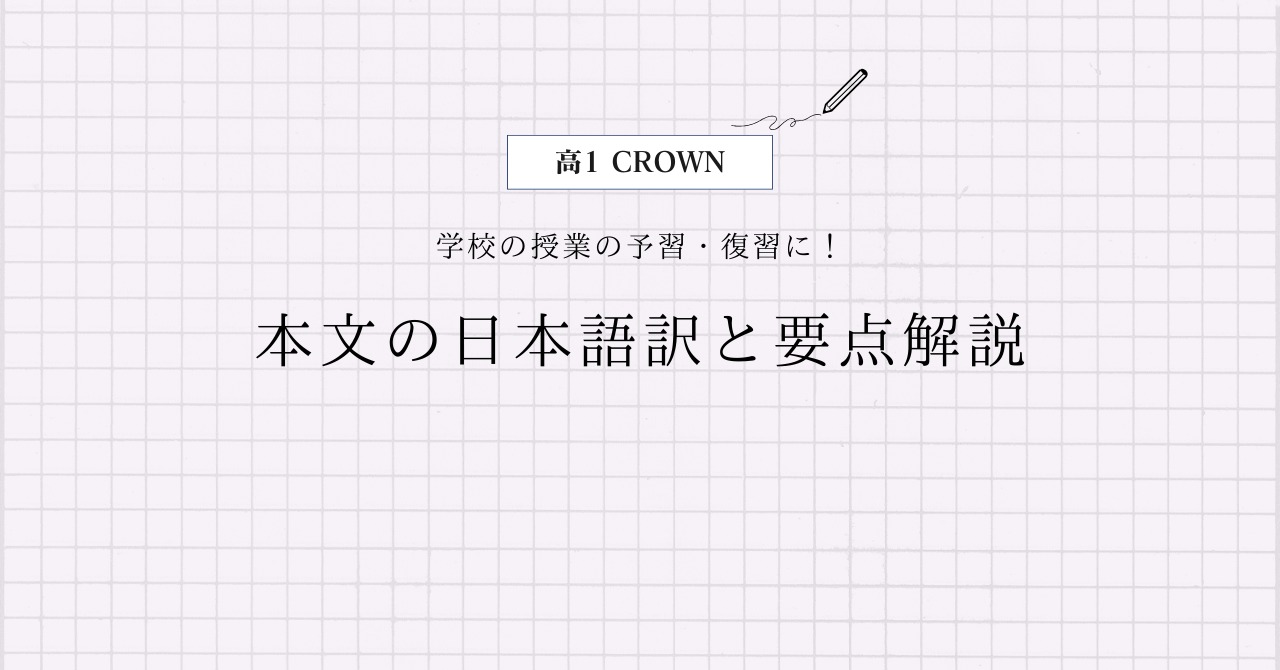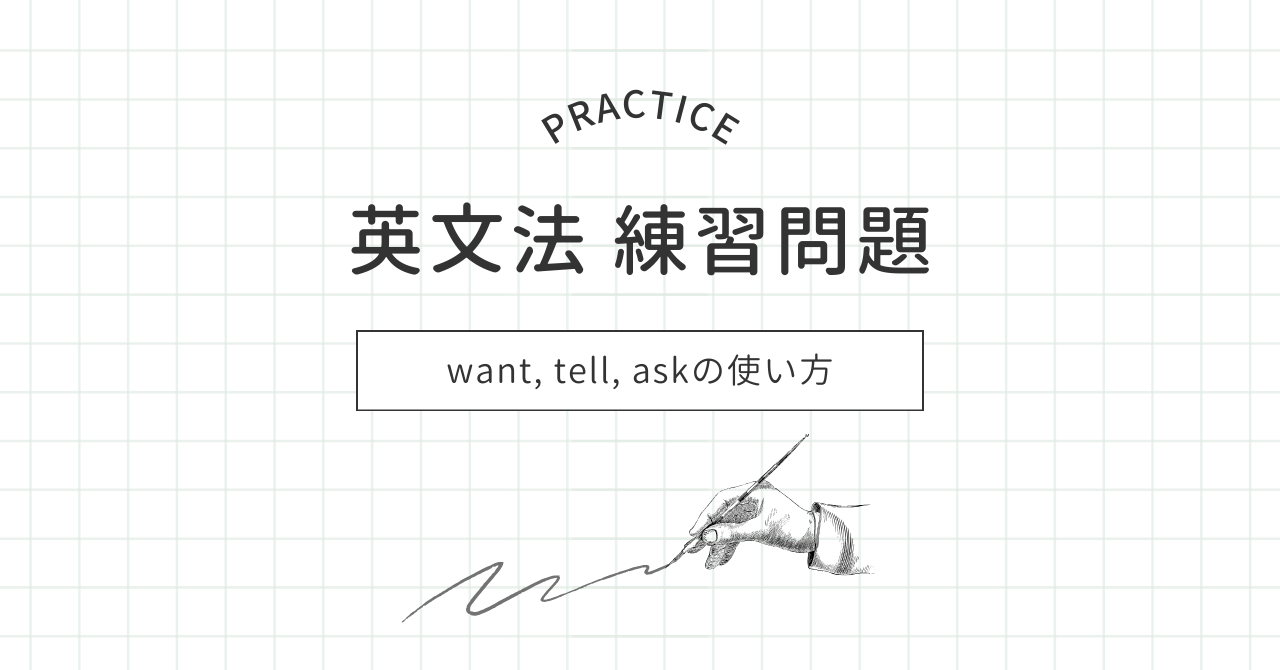三省堂 高1CROWN English Communication1 Lesson8 Section1の本文の日本語訳と重要箇所の解説です。
Section8-2, 8-3, 8-4の解説はこちらからご覧ください。
>高1CROWN English Communication1 Lesson8 Section2 本文和訳
>高1CROWN English Communication1 Lesson8 Section3 本文和訳
>高1CROWN English Communication1 Lesson8 Section4 本文和訳
- CROWN English Communication1 Lesson8 Section1 本文と日本語訳
- CROWN English Communication1 Lesson8 Section1 重要事項の解説
- A group of high school students is visiting a photo exhibition featuring the 20th century.
- A museum guide speaks to the students.
- Today I’m going to take you back to the 20th century.
- It may seem to you like ancient history, but in fact, it really was not so long ago.
- The 300 photographs in this exhibition show us the history of the past century.
- The 20th century was an age of great progress in science and communications.
- People’s lives became richer and more comfortable.
- People achieved greater freedom and equality, and seemed to be closer to the dream of living a happy life.
- But it was also an age of terrible wars, and tens of millions of people lost their lives.
- The photos here will show you what people like you and me went through in the 20th century.
- As you look at them, ask yourself: “How would you feel if these were photos of your own family and friends?”
- Some will shock you; some may make you sad or angry.
- But they will also give you a message for our future.
- First of all, I would like to show you two photographs which are particularly important to us.
- CROWN English Communication1 Lesson8 Section1 まとめ
CROWN English Communication1 Lesson8 Section1 本文と日本語訳
Not So Long Ago
「それほど遠くない昔」
A group of high school students is visiting a photo exhibition featuring the 20th century.
「高校生のグループが、20世紀を特集している写真展示会を訪れています。」
A museum guide speaks to the students.
「博物館のガイドが生徒たちに話しかけています。」
Today I’m going to take you back to the 20th century.
「今日は、あなたたちを20世紀に連れて行きます。」
It may seem to you like ancient history, but in fact, it really was not so long ago.
「それはあなたたちにとって昔の歴史のように思えるかもしれませんが、実際は、それほど遠い昔のことではなかったのです。」
The 300 photographs in this exhibition show us the history of the past century.
「この展示会の300枚の写真が、私たちに過去1世紀の歴史を見せてくれます。」
The 20th century was an age of great progress in science and communications.
「20世紀は科学と情報伝達が大きく発達した時代でした。」
People’s lives became richer and more comfortable.
「人々の生活はより豊かに、そして快適になりました。」
People achieved greater freedom and equality, and seemed to be closer to the dream of living a happy life.
「人々はより大きな自由と平等を獲得し、幸せな生活を送るという夢により近づいたように思えました。」
But it was also an age of terrible wars, and tens of millions of people lost their lives.
「しかし、20世紀は恐ろしい戦争の時代でもあり、数千万人の人々が生活を失いました。」
The photos here will show you what people like you and me went through in the 20th century.
「ここの写真は、あなたや私のような人々が20世紀に何を経験したのかを見せてくれます。」
As you look at them, ask yourself: “How would you feel if these were photos of your own family and friends?”
「写真を見ながら、自分に聞いてみてください。『もしこれらが自分の家族や友達の写真だったらどう感じるだろうか。』と。」
Some will shock you; some may make you sad or angry.
「あなたにショックを与えるものもあれば、あなたを悲しくさせたり、怒らせる写真もあるでしょう。」
But they will also give you a message for our future.
「しかし、それらは私たちの未来へのメッセージも与えてくれるでしょう。」
First of all, I would like to show you two photographs which are particularly important to us.
「まず、私たちにとって特に大事な2枚の写真を見せたいと思います。」

CROWN English Communication1 Lesson8 Section1 重要事項の解説
A group of high school students is visiting a photo exhibition featuring the 20th century.
この文は「現在進行形」が使われていますね。
“of”は前置詞で,”A of B”の形で「BのA」というように後ろから前に訳します。
“photo”は「写真」、“exhibition”は「展示会」、“century”は「世紀」という名詞です。
“feature”は「を特集する、を呼び物にする」という動詞で、ここでは「現在分詞」になっていますね。
“featuring the 20th century”が直前の“a photo exhibition”を修飾しています。
A museum guide speaks to the students.
“museum”は「博物館、美術館」,“guide”は「案内人、ガイド」という名詞ですね。
“speak to 人”は「に話しかける」という表現です。
Today I’m going to take you back to the 20th century.
この文は「未来形」になっています。
“take 人 back to~”は「人を~に戻す」といった意味です。ただ今回は「連れて行く」と訳しました。
It may seem to you like ancient history, but in fact, it really was not so long ago.
“It”は“the 20th century”を指しています。“may”は「~かもしれない」という助動詞ですね。
“seem”は「~のようだ,と思われる」という動詞で、“seem like 名詞”で「名詞のように思える」という意味になります。
ここの“to”は前置詞で「~にとって」という意味で、“ancient”は「古代の、昔の」という形容詞、“history”は「歴史」という名詞ですね。
“in fact”は「実際は」という重要表現です。
この“it”も“the 20th century”を指していて、“really not~”は「あまり~ではない」という意味になります。
“long ago”は「ずっと昔に」といった意味なので、合わせて「あまり昔のことではなかった」と訳しました。
The 300 photographs in this exhibition show us the history of the past century.
“photograph”は「写真」という名詞ですね。“photo”は“photograph”の省略形です。
“show 人 もの”で「人にものを示す,見せる」となって,“show もの to 人”でも同じ意味になります。
“past”は「過去の」という形容詞です。
The 20th century was an age of great progress in science and communications.
“age”は「時代、年齢」、“progress”は「進展、発達」、“communication”は「情報伝達、意思疎通」といった名詞です。
People’s lives became richer and more comfortable.
名詞に‘sを付けると「~の」という所有を表します。
直前の名詞が複数形のときは” teachers‘ “のようにアポストロフィーだけを最後に付けます。
“lives“は“life(生活,人生)“の複数形で,語尾が”f,fe”で終わる名詞を複数形にするときは”f,fe”を取って”ves”をつけます。
knife→knives(ナイフ), leaf→leaves(葉)などがあります。
“became”は“become(~になる)”の過去形で、”rich”は「豊かな、裕福な」、“comfortable”は「快適な、心地よい」という形容詞になります。ここでは「比較級」になっていますね。
People achieved greater freedom and equality, and seemed to be closer to the dream of living a happy life.
“achieve”は「を獲得する、達成する」という動詞です。
“freedom”は「自由」、“equality”は「平等」という名詞で、“greater”も「比較級」になっていますね。
“seem to 動詞の原形”は「~と思われる」という表現で、“close to~”は「~に近い」という意味になります。これも「比較級」ですね。
“live”は「~を送る」という動詞で、ここでは「動名詞」になっています。
But it was also an age of terrible wars, and tens of millions of people lost their lives.
“it”は“the 20th century”を指しています。
“also”は「また,さらに」といった副詞で,付け加える役割があります。色々な文で使うので必ず覚えましょう!
“terrible”は「恐ろしい」という形容詞で、“war”は「戦争」という名詞になります。
“tens of millions of~”は「数千万の~」という表現で、“lost”は“lose(を失う)”の過去形ですね。
“lives”は「生活」と訳しましたが、「命」でもいいと思います。
The photos here will show you what people like you and me went through in the 20th century.
“here”は「ここで,ここに」といった副詞ですね。
“what people like you and me went through in the 20th century”は「間接疑問文」ですね。
“like”は「~のような」という前置詞で、“go through~”は「を経験する、体験する」という表現になります。
As you look at them, ask yourself: “How would you feel if these were photos of your own family and friends?”
“as”は「~しながら」という接続詞です。ほかにも「~のとき」や「~だから」といった意味もあるので、文脈に応じて変えてあげましょう。
“them”は“The photos”を指していますね。
“ask”は「を尋ねる、聞く」という動詞で、ここでは「命令文」になっています。
“yourself”は「あなた自身」という再帰代名詞で,主語と目的語が同じになるときは,目的語を再帰代名詞を使って表現します。今回は「命令文」なので、主語は書いてないですが“You”になります。
「:」は「コロン」と言い,簡単に言うと「つまり」という具合に直前の文章を補足します。コロンを使うときは,コロンの前は必ず文にしないといけない点に注意してください。
“How would you feel?”は「あなたはどう感じますか?」という意味で、“do”ではなく“would”を使うことで丁寧なニュアンスになります。
“if”は「もし~なら」という接続詞ですね。
“these”は“this”の複数形で,「これらは(の)」といった意味になります。
Some will shock you; some may make you sad or angry.
“some”は主語として使うと「~もあれば,…もある」といった意味になります。今回は“photos”のことを指していますね。
“shock”は「にショックを与える、衝撃を与える」という動詞です。
「;」は「セミコロン」といって,2つの文章を繋ぐ「接続詞」のような働きをします。
“make 名詞 形容詞/名詞”で、「名詞を~(の状態)にする、させる」という重要表現です。
“sad”は「悲しい」、“angry”は「怒った」という形容詞ですね。
But they will also give you a message for our future.
“they”は“photos“を指していますね。
“give 人 もの”で「人にものを与える」となって,“give もの to 人”でも同じ意味になります。
First of all, I would like to show you two photographs which are particularly important to us.
“first of all”は「まず、最初に」という重要表現です。
“would like”は“want”と同じ「が欲しい」という意味で,“would like to 動詞の原形”で「~したい」という重要表現になります。
また,“which”は「主格の関係代名詞」で,“which are particularly important to us”が先行詞“two photographs”を修飾していますね。
“particularly”は「特に」という副詞になります。
CROWN English Communication1 Lesson8 Section1 まとめ
以上がCROWN English Communication1 Lesson8 Section1の日本語訳となります。
「分詞構文」「関係副詞」などの使い方をしっかり確認しておきましょう!
>高1CROWN English Communication1 Lesson8 Section2 本文和訳
>高1CROWN English Communication1 Lesson8 Section3 本文和訳
>高1CROWN English Communication1 Lesson8 Section4 本文和訳
何か分からない点や他に解説してほしい点があれば,お気軽にコメントしてください!




コメント